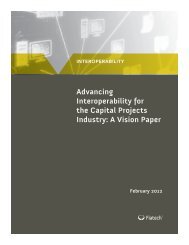An Introduction to ISO 15926 November 2011 - iRINGToday
An Introduction to ISO 15926 November 2011 - iRINGToday
An Introduction to ISO 15926 November 2011 - iRINGToday
You also want an ePaper? Increase the reach of your titles
YUMPU automatically turns print PDFs into web optimized ePapers that Google loves.
On<strong>to</strong>logy of<br />
Things That<br />
Will Carry a<br />
Bicycle<br />
Pickup Truck<br />
Pickup Truck with a<br />
Camper that is not full<br />
of stuff<br />
F150<br />
Felicia Fun<br />
Fig. 2.4 On<strong>to</strong>logy of things that will carry a bicycle.<br />
Similarly, when we use a machine-readable on<strong>to</strong>logy <strong>to</strong> organize and s<strong>to</strong>re information we<br />
make it possible for machines <strong>to</strong> make inferences. If two applications use the same on<strong>to</strong>logy<br />
<strong>to</strong> s<strong>to</strong>re information it will be much easier for them <strong>to</strong> exchange information, and <strong>to</strong> preserve<br />
the meaning of the information during the exchange.<br />
There has been a great deal of study on the subject of on<strong>to</strong>logies in an effort <strong>to</strong> implement<br />
the vision of the Semantic Web. A number of <strong>to</strong>ols have been developed <strong>to</strong> make it easier <strong>to</strong><br />
create and share on<strong>to</strong>logies. One of the more important of these is OWL, which is being incorporated<br />
in<strong>to</strong> Part 8 of <strong>ISO</strong> <strong>15926</strong>.<br />
Open Ways <strong>to</strong> S<strong>to</strong>re and Exchange Data<br />
For machines <strong>to</strong> be able <strong>to</strong> understand what data means, we need <strong>to</strong> see how <strong>to</strong> s<strong>to</strong>re data in<br />
a way that retains its meaning without being dependent on proprietary software or short-lived<br />
hardware. Since the invention of writing at about 3000 B.C., people have used all manner of<br />
what we now call hard copy <strong>to</strong> record information. The Library of Alexandria, which burned<br />
down in 48 B.C., according <strong>to</strong> one account, 2 is an example of the best technology for managing<br />
information in hard-copy form and of a major limitation of doing so. With the advent of<br />
computer-managed s<strong>to</strong>rage in the mid twentieth century, information managers have had <strong>to</strong><br />
grapple with two problems.<br />
• Survival of information beyond the lifetime of proprietary hardware and software<br />
• Moving a large amount of information between proprietary systems<br />
A typical example of these types of questions is a help desk inquiry from the<br />
mid 1980s.<br />
2 Look up “Library of Alexandra” in Wikipedia.<br />
CHAPTER 2<br />
44



